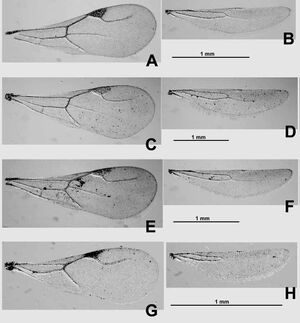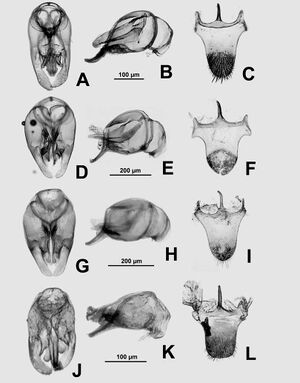Probolomyrmex longiscapus
| Probolomyrmex longiscapus | |
|---|---|

| |
| Scientific classification | |
| Kingdom: | Animalia |
| Phylum: | Arthropoda |
| Class: | Insecta |
| Order: | Hymenoptera |
| Family: | Formicidae |
| Subfamily: | Proceratiinae |
| Tribe: | Probolomyrmecini |
| Genus: | Probolomyrmex |
| Species: | P. longiscapus |
| Binomial name | |
| Probolomyrmex longiscapus Xu, Z. & Zeng, 2000 | |
Nothing is known about the biology of Probolomyrmex longiscapus.
Identification
Eguchi et al. (2006) - In the worker and queen, P. longiscapus is most similar to Probolomyrmex longinodus (see under P. longinodus), and relatively similar to Probolomyrmex watanabei. It is well separated from P. watanabei by the posterodorsal margin of petiole not produced medially and antennal segment III a little longer than IV in the worker and queen. In the male, P. longiscapus is also very similar to P. longinodus, but the former can be separated from the latter by the following characteristics: 1) distinctly elongate mandibles, without teeth other than an apical tooth on the masticatory margin, 2) shorter and broader apical segment of maxillary palp, 3) steeper posterior slope of petiolar node and angular posterodorsal corner of the node, 4) weaker protrusion of metanotum in lateral view.
Keys including this Species
Distribution
China (Yunnan) and N. Vietnam.
Latitudinal Distribution Pattern
Latitudinal Range: 21.93166667° to -3.633333°.
| North Temperate |
North Subtropical |
Tropical | South Subtropical |
South Temperate |
- Source: AntMaps
Distribution based on Regional Taxon Lists
Oriental Region: Laos.
Palaearctic Region: China (type locality).
Distribution based on AntMaps
Distribution based on AntWeb specimens
Check data from AntWeb
Countries Occupied
| Number of countries occupied by this species based on AntWiki Regional Taxon Lists. In general, fewer countries occupied indicates a narrower range, while more countries indicates a more widespread species. |

|
Estimated Abundance
| Relative abundance based on number of AntMaps records per species (this species within the purple bar). Fewer records (to the left) indicates a less abundant/encountered species while more records (to the right) indicates more abundant/encountered species. |

|
Biology
Castes
Male
 
| |
| . | |
Nomenclature
The following information is derived from Barry Bolton's Online Catalogue of the Ants of the World.
- longiscapus. Probolomyrmex longiscapus Xu & Zeng, 2000: 216, figs. 9-11 (w.) CHINA (Yunnan).
- Type-material: holotype worker, 1 paratype worker.
- Type-locality: holotype China: Yunnan, Mengla County, Nanqian Village, 820 m., 11.iii.1998, no. A98-537, soil sample (G. Zeng); paratype with same data.
- Type-depository: SFCY.
- Eguchi, Yoshimura & Yamane, 2006: 18 (q.m.).
- Status as species: Eguchi, Yoshimura & Yamane, 2006: 16 (redescription); Zhou & Ran, 2010: 110; Guénard & Dunn, 2012: 62; Jaitrong, Guénard, et al. 2016: 43.
- Distribution: China, Laos, Vietnam.
Unless otherwise noted the text for the remainder of this section is reported from the publication that includes the original description.
Description
Worker
Holotype: TL 3.0, HL 0.70, HW 0.45, CI 64, SL 0.60, SI 133, PW 0.36, AL 0.96, PNL 0.38, PNW 0.20, PH 0.26. Head distinctly longer than broad, anterior 1/4 narrowed obviously. Occipital margin nearly straight, very shallowly emarginate, occipital corner blunt. Lateral sides of head evenly convex. Anterior margin of clypeus convex. Frontal carinae erect, close to each other and parallel for most of their length, anterior apices reached to anterior margin of clypeus. Apex of scape almost reached to occipital margin. Antennal segments 3-6 about as broad as long, segments 7-11 broader than long. In full-face view mandibles invisible. In profile view dorsum of alitrunk straight, promesonotal suture and metanotal groove absent. Propodeum with a pair of triangular teeth, declivity depressed and marginate laterally. In profile view petiolar node longer than high, anterior and dorsal faces formed an even arch, posterodorsal corner formed an acute angle, posterior face depressed and marginate laterally. Ventral face of petiole convex, anteroventral corner with a slender tooth. In dorsal view petiolar node rectangular, lateral sides nearly parallel, posterior 1/3 narrowed backward, posterior border straight. Constriction between the two basal segments of gaster distinct. Surfaces of head !ftnd the whole .bo dy shagreened. Head and alitrunk weakly and sparsely punctured. Petiole and gaster distinctly punctured. Dorsum of head and body, and appendages without erect hairs, but with dense decumbent short pubescence. Body in color reddish brown.
Paratype: TL 2.8, HL 0.70, HW 0.44, CI 63, SL 0.60, SI 136, PW 0.34, AL 0.94, PNL 0.38, PNW O. 19, NH 0.24 (n = 1). As holotype.
Eguchi et al. (2006) - HL, 0.77–0.79 mm; HW, 0.47–0.48 mm; SL, 0.67–0.69 mm; CI, 61–62; SI, 142–147; WL, 1.13–1.18 mm; PW, 0.39–0.40 mm; DPtW, 0.21–0.23 mm; DPtI, 53–58; PtH, 0.28–0.30 mm; PtNL, 0.41–0.43 mm; LPtI, 141–146 (N=5). Nontype workers belonging to a single colony from N. Vietnam agree well with the original description (Xu & Zeng, 2000), but the following small differences are recognized in the former: petiole in dorsal view weakly widened around the midlength; posterodorsal part of petiole in dorsal view with a slight median emargination; gaster not so distinctly punctured dorsally.
Queen
Eguchi et al. (2006) - (teneral alate queen). HL, 0.75–0.76 mm; HW, 0.47–0.48 mm; SL, 0.66–0.67 mm; EL, 0.15 mm; CI, 62–64; SI, 140; EI, 31–32; WL, 1.20–1.22 mm; PW, 0.44–0.46 mm; DPtW, 0.23 mm; DPtI, 50; PtH, 0.30–0.31 mm; PtNL, 0.41 mm; LPtI, 132–137 (N=2, but N=1 for DPtW and DPtI). Head in full-face view elongate, with weakly convex sides and almost straight occipital border. Frontal carina in profile relatively high as in the worker (Fig. 9D). Eye a little longer than the width of apical antennal segment. Antennal scape when laid backward extending beyond the level of posterior margin of lateral ocelli; relative lengths of antennal segments II–XII as in the worker (see Fig. 10D); segment III a little longer than IV; IV a little longer than broad. Pronotum large; mesoscutum ca. 1.3 times as long as broad, in profile very weakly convex, without notauli; parapsidal lines very fine; scuto-scutellar suture fine, very weakly and roundly curved posteriad; scutellum in profile with steep posterior slope; axilla poorly separated from scutellum by an obscure impression but not by a suture; mesopleuron (except in its posteriormost part) well divided by a suture into anepisternum and katepisternum; raised median portion of metanotum with gentle lateral slopes; suture between metepisternum and propodeum absent; a deep depression present dividing metepisternum into anepisternum and katepisternum; orifice of metapleural gland small, opening posterolaterad; posterior margin of dorsum of propodeum in dorsal view moderately concave; posterior face of propodeum margined laterally with a carina which forms a triangular propodeal spine; outline from propodeal spine to propodeal lobe in profile weakly concave. Petiole including subpetiolar process much longer than high, in profile with weakly concave posterior outline (above the articulation with gaster), in dorsal view weakly widened around midlength; posterodorsal margin of petiolar node in dorsal view with a shallow median emargination/concavity; subpetiolar process inconspicuous, only with an acute anterior projection. Abdominal segment III (gastral segment I) in profile relatively short, gently narrowed anteriad in the anterior 3/4. Wing structure and venation as in the male. Hind wing with three hamuli.
Male
Eguchi et al. (2006) - HL, 0.54 mm; HW, 0.58 mm; CI, 107; HD, 0.50 mm; HDI, 93; EL, 0.28 mm; SL, 0.41 mm; SI, 71; MstlL, 0.20 mm; MstlW, 0.20 mm; MstlI, 100; WL, 1.13 mm; PtNL, 0.39 mm; PtH, 0.27 mm; LPtI, 144 (N=1). Head in lateral view relatively thick (HDI>90.00); protrusion of frontoclypeal region relatively long so that antennal insertion is situated in the middle of its dorsal surface. Frontal carina high, and distinctly exceeding posterior margin of antennal insertions in full-face view. Eye relatively broad, strongly widened ventrally. Antennal flagellum relatively long, filiform; antennal segment III distinctly longer than segment II; segment XI (the third from apex) distinctly longer than broad; ventrolateral surface of the apical segment not concave. Mandible elongated-triangular, with only a single strong apical tooth on its masticatory margin; basal angle rounded and indistinct. Palpal formula: maxillary 4, labial 2; maxillary palp moderately long; the third palpomere distinctly longer than the second, the apical distinctly longer than the third. Pronotum in profile distinctly higher than mesoscutum; metanotum moderately produced posteriorly, and a suture separating it from mesoscutellum weakly notched; anepisternum of metapleuron separated from metakatepisternum and propodeum by a deep furrow; a suture between metakatepisternum and propodeum very weak, unclear; dorsal margin of the propodeum forming a weak angle with the posterior slope. With the mesosoma in dorsal view, mesonotum lacking notauli; parapsidal lines distinct; axillae distinct; mesoscutellum broader than long; declivitous face of the propodeum very slightly concave with weak, obtuse lateral lamellae. Petiole in lateral view without a distinct peduncle; its node long with gentle anterior slope and steep posterior slope; posterodorsal margin angular; subpetiolar process narrowly developed and its apex sharp. Abdominal sternum IX long; its apical margin gently pointed medially. Genitalia retractile. With the phallus in lateral view, the basal ring moderately long and its dorsal margin gentle; basiparamere with the dorsal margin gently raised in its basal portion, and posterodorsal margin angular; digitus volsellaris simply curved ventrally in its apical portion; penis valve distinctly narrowed apically; its apical portion relatively sharp and slightly curved ventrally. Paramere thin; its expanded inner faces directed ventrally with the apical portion not curved dorsally. Aedeagal apodeme relatively broad. On fore wing, costa and radius apical to stigma vestigial; Rsf2 and Rsf3 completely absent; radial sector never reaching costal margin; Mf1, Rs+M and media apical to Rs+M present; cu-a cross vein present. On hind wing, Rsf4+5 present; jugal lobe absent.
Type Material
Eguchi et al. (2006) - Holotype: worker, Nanqian Village, Mengla County, Yunnan Province, China, 11/iii/1998, G. Zeng (Southwest Forestry College, Yunnan, China) [not examined]. Paratype: 1 worker with same data as the holotype (Southwest Forestry College) [not examined].
References
- Eguchi K. Yoshimura M. and Yamane S. 2006. The Oriental species of the ant genus Probolomyrmex (Insecta: Hymenoptera: Formicidae: Proceratiinae). Zootaxa 1376:1-35.
- Ito, F., Hosokawa, R. 2020. Biological notes of Probolomyrmex okinawaensis Terayama & Ogata collected in Yonagunijima Island, and five species of Probolomyrmex collected in Japan and Southeast Asia. Asian Myrmecology 12, e012003 (doi:10.20362/am.012003).
- Liu, C., Fischer, G., Hita Garcia, F., Yamane, S., Liu, Q., Peng, Y.Q., Economo, E.P., Guénard, B., Pierce, N.E. 2020. Ants of the Hengduan Mountains: a new altitudinal survey and updated checklist for Yunnan Province highlight an understudied insect biodiversity hotspot. ZooKeys 978, 1–171 (doi:10.3897/zookeys.978.55767).
- Xu, Z.-H.; Zeng, G. 2000. Discovery of the worker caste of Platythyrea clypeata Forel and a new species of Probolomyrmex Mayr in Yunnan, China. Entomologia Sinica 7: 213-217 (doi:10.1111/j.1744-7917.2000.tb00410.x). (page 216, figs. 9-11 worker described)
References based on Global Ant Biodiversity Informatics
- Asfiya W., L. Lach, J. D. Majer, B. Heterick, and R. K. Didham. 2015. Intensive agroforestry practices negatively affect ant (Hymenoptera: Formicidae) diversity and composition in southeast Sulawesi, Indonesia. Asian Myrmecology 7: 87-104.
- Eguchi K.; Yoshimura M.; Yamane S. 2006. The Oriental species of the ant genus Probolomyrmex (Insecta: Hymenoptera: Formicidae: Proceratiinae). Zootaxa 1376: 1-35.
- Eguchi, K., M. Yoshimura, and S. Yamane. "The Oriental species of the ant genus Probolomyrmex (Insecta: Hymenoptera: Formicidae: Proceratiinae)." Zootaxa 1376 (2006): 1-35.
- Guénard B., and R. R. Dunn. 2012. A checklist of the ants of China. Zootaxa 3558: 1-77.
- Jaitrong W., B. Guenard, E. P. Economo, N. Buddhakala, and S. Yamane. 2016. A checklist of known ant species of Laos (Hymenoptera: Formicidae). Asian Myrmecology 8: 1-32. DOI: 10.20362/am.008019
- Xu Z. and Zeng G. 2000. Discovery of the worker caste of Platythyrea clypeata Forel and a new species of Probolomyrmex Mayr in Yunnan, China (Hymenoptera: Formicidae). Entomologia Sinica 7(3): 213-217.



